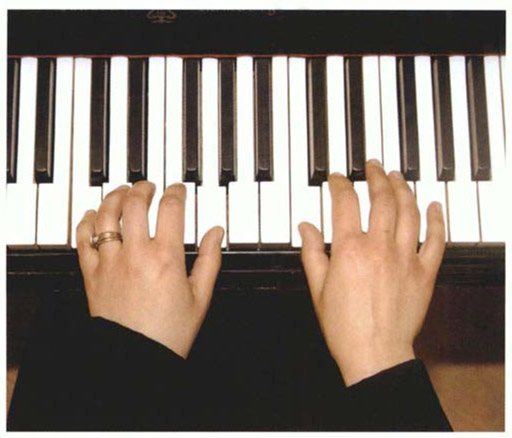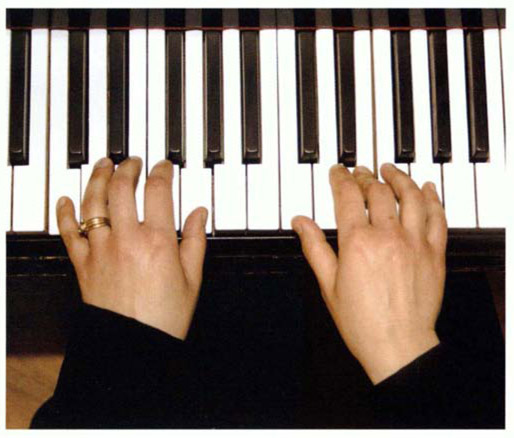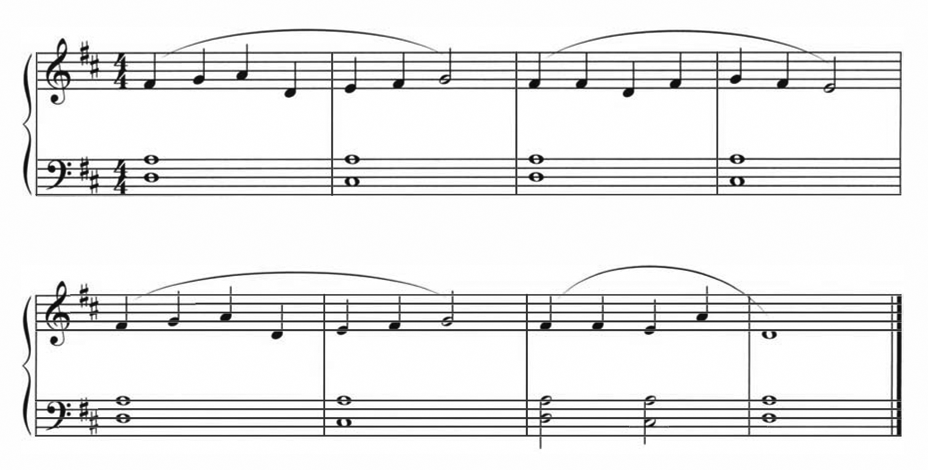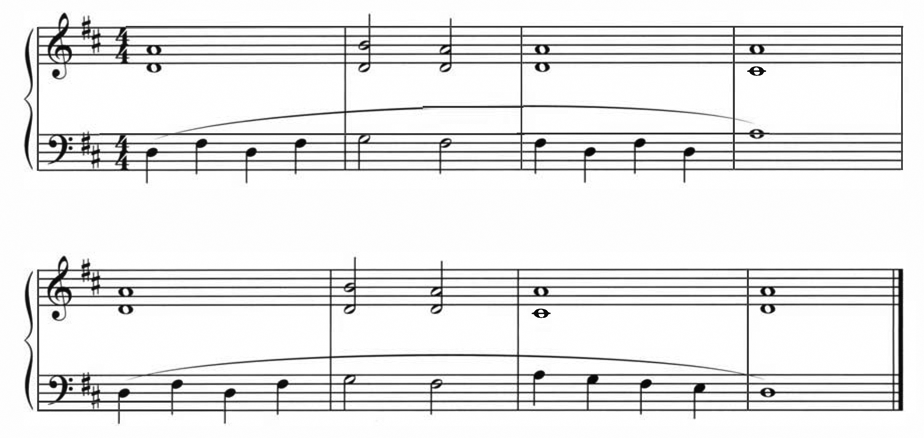ACCOMPANY WITH 5THS & 6THS
Accompany each note of the major five-finger pattern with either a 5th or a 6th
Your brain may be smoking from all that focus on keys and chords. Pull back a little and play a familiar five-finger pattern in the RH. Accompany each note with an interval of a 5th or a 6th. Play slowly and listen. Which combination sounds best? Can you reason why?
The secret is knowing which notes are triad tones. Once you know the triad tones, and the non-triad tones, you can accompany the triad tones with a 5th, the non-triad tones with a 6th.
RH on C, LH on Blocked 5th
- When you accompany each note of the five-finger pattern, the left hand will play an interval of a 5th with triad tones.
- Name the triad notes in C major. Play each one with a PSth in the left hand.
- Now reverse—left hand play the triad notes, right hand play the P5th.
Once you have perfected the accompaniment of the major five-finger pattern in C major, try it in G major. When you changed from 5th to 6th in the key of C, the left hand 5th finger moved down a half step (and the other fingers went along for the ride, making the gap between fingers 1 and 2). In G major, when your left hand switches from 5th to 6th, the fifth finger must move to F#. Changing from 5th to 6th by moving the left hand thumb involves white keys only. In the key of F major you have only the white keys when you change to the 6th either way.
RH on D, LH on Blocked 6th
- Your left hand wants to move to a 6th when you play D in the right hand.
- Try both 6ths; the thumb moving away from the hand, the fingers moving away from the thumb.
- Which one sounds the best? Do you know why?
The key of D major is similar to G major, because, to move from a 5th to a 6th, the fifth finger (or thumb, in right hand) must go to a black key (C#).
RH on E, LH on Blocked 5th
- Now the melody note is E. You can shift your left hand back to the 5th.
- Practice playing each note of the triad with the P5th in the left hand. Go up and down, play two notes at the same time.
These 5ths and 6ths are the outside notes of triads and triad inversions. Think of the whole triad at least one time during this practice. Which middle key will it be? Can you think through it, or experiment with the sound by adding the one key in the middle?
Become immersed in these patterns accompanied by 5ths and 6ths. The easier they are, the easier the next step will be.
RH on F, LH on Blocked 6th
- The right hand plays 4th finger on F.
- The left hand moves to a 6th. Try it both ways—thumb away from fingers, fingers away from thumb
- Which 6th sounds the best? Why?
Track 74 
LEARN TO ACCOMPANY
Now use your ear and your knowledge to accompany a simple five-finger tune
Study and play the melody; decide where you want to accompany with a 5th or a 6th. Mark it under the melody notes. Play it hands together and listen. Do you like the sound?
There are many books in which there are simple melodies to play and to accompany. Look through music at your local music store, or do a search on the Internet. Beyond this, keep playing five-finger patterns and mixing up the notes. Instead of playing fingers 1-2-3-4-5 in the right hand, play fingers 1-3-2-4-3-5. Another mix can be 2-1-3-2-4-3-5. You can jot down these finger patterns in order to remember them and keep them right in front of you. You can reverse the patterns (5-3-4-2-3-1, for instance), or make new ones. Any one of these combinations might remind you of a familiar song.
- Here is a melody for which there is no accompaniment. On beat one of each measure decide if you want to play a 5th or a 6th.
- Mark in pencil on the 1st beat of each measure which interval you will use—5th or 6th.
- Is there a measure in which you will need to change the left hand halfway through the measure?
Remember that for accompaniment you can use the perfect 5th all the way through the piece. The only decision you have to make is when to play it. Next, you can play one note of the 5th, or the other; i.e. finger 5 or finger 1. Again, you only have to decide which note sounds better in which measure.
The next step is to play 5ths and 6ths. Perhaps the change will come in the same place you changed from finger 5 to finger 1 in the last version.
Go back in the book and play melodies that you played before. They are much easier now! Use the advice for accompanying to add a left hand part. Try just the P5th all the way through; then 5 finger or finger 1; then a blocked 5th or 6th.
- Another melody with my accompaniment written out.
Track 74 
SWITCH HANDS
Another example of equal time for both hands
Your brain will really light up from this one! Can you play the melody in the left hand and accompany with 5ths and 6ths in the right hand? This is one way to get the hands-together routine going.
Another exercise is to play both hands up and down a five-finger pattern, right hand legato, left hand staccato. Try this at four beats to a note, then two beats, then one beat. When this is getting easy, reverse: right hand staccato, left hand legato. Go through the same routine. Your brain is “smoking” now!
LH G, RH P5th
- The left hand plays the melody note, G, with finger 5.
- The right hand accompanies with a P5th.
- Play up and down the triad in the left hand, while the right hand holds the P5th.
A trick I find helpful in my own practice is to play the left hand part of a particular piece with the right hand. You can move down the bench so that it is comfortable to play it straight in front of you, or you can play it an octave higher so you don’t have to move. Now reverse: play the right hand part with the left hand, in a comfortable position.
LH A, RH 6th
- The left hand plays the melody note, A.
- The right hand moves to a 6th to accompany.
- Try playing both 6ths—thumb away from fingers, fingers away from thumb—to decide which sounds the best to you.
- Do you know the reason for your choice, besides the fact that you think it sounds better?
Yet one more exercise: Play the right hand part fortissimo and the left hand part pianissimo. Then reverse that process.
If you ask pianists and piano teachers for their tips on practicing, these ideas and more will be suggested. Teachers have many different ways to get their pupils to reach the same goal: to play with ease and confidence and to achieve a rich sound up and down the keyboard.
- A five-finger melody for the left hand; what a concept!
- Imagine a bassoon or trombone playing this tune.
Track 75 
ACCOMPANY THE MAJOR SCALE
Expand your melody to include each note of the major scale
You can play a 5th to a 6th by moving either the thumb away from the hand, or the fingers away from the thumb. After practicing this, play each note of the scale (C major is easiest at this point) in the right hand, and accompany each note with either the 5th, or one of the 6ths. Experiment with both 6ths; decide which one sounds the best to you, then try to reason why. By playing this 5th and 6th accompaniment, you are really playing I to V or I to IV, without the middle notes to complete the chords. Now you can play the whole chord with each melody note; you may change your mind about the choices of accompanying notes.
If you know the first phrase of “Joy to the World,” you can play it (it is a major scale descending) with the 5th-6th accompaniment. If this is easy, try the whole chord, played with each note.
- The C major scale is in the right hand; your accompaniment of 5ths and 6ths is in the left hand.
If you know the first phrase of “The First Noel,” you can play it (it is a major scale ascending, after the first two notes) with chord as accompaniment. Remember, you are filling in the middle note of the 5ths and 6ths. Since both these holiday songs have some fast notes, you don’t have to accompany every note of the melody. “First Noel” is in 3/4 time, so play your accompanying chord, or 5th or 6th, on the word “first.” The next accompanying figure plays with the syllable “-el.” Do you feel the 1-2-3 of the rhythm?
“Joy to the World” is in 2/4. The left hand plays with the word “Joy,” then “world” Or you can play on every beat of most measures. Try out different ways to accompany, including single notes in the bass (just the name of each chord).
Joy
- Keep playing up the scale with the accompaniment in the left hand.
- When this starts to feel easy, you can do two things: go faster, or change keys.
Track 76 
CHALLENGE YOUR BRAIN!
Light up your brain; switch hands
Now it is time to put the scale in the left hand and accompany with the right hand. Make sure you can play the scale easily in the left hand. Then fit the 5th or the 6th to each note. On some notes both a 5th and a 6th fit nicely and sound good. You have to decide which one you prefer. Go slowly! Listen!
Other ways to challenge your brain: When you play the 5th in the left hand, play up the accompanying triad in the right hand. (RH plays C-E-G) On degree two of the scale, left hand will play a 6th, right hand will play D-F-G. Continue this way up the scale. When you have done this, put the scale back in the left hand, and therefore the triads, and the 5ths and 6ths in the right hand. Some of the combinations sound good, others do not sound as good. But it is fun to experiment.
- I have written out the scale in the left hand, and indicated where the 5th or 6th should go.
Another way to have fun and challenge your brain is to play lots of broken chords, hand over hand, up and down the piano keyboard, with the damper pedal down. Play major, then minor chords. Be sure and let the pedal up between chords, so the sound does not get murky. Or you may like the murky sound. Go with it!
GREEN●LIGHT
An example of “impressionistic” sounds in classical music is Claude Debussy’s “Sunken Cathedral,” “Clair de Lune,” and “Reflets dans l’eau.” Maurice Ravel wrote “Jex d’eau” and “Ondine.”
Go Tell Aunt Rhody
- Another melody for the left hand, or maybe the double bass?
Track 77 
APPLY YOUR KNOWLEDGE
Now that you have rehearsed accompanying scale notes, transfer the knowledge to a real tune
Analyze the melody; practice it until it feels easy and comfortable. Plan the accompaniment by writing in a 5th or a 6th below notes where you think it will sound good. Practice the left hand alone until it feels easy. Now play the hands together. How does it sound? Make changes where needed.
If you have music paper, write out a tune that you can copy, or you can play on the piano. Plan an accompaniment the same way. Study the melody for triad tones (that is, the I chord), tones that are not in the triad, tones that are in other triads. Plan the spots for your accompaniment; mark it in the music. Then play hands together. Fix the places that do not sound good. Play it again; keep a steady beat!
Cuckoo
Track 78 
Can you change a tune from major to minor? Why not? It’s a good exercise. Choose the parallel minor key; make sure you can play the scale of the minor key three ways: natural, harmonic, and melodic. Play one of the melodies below, or another tune you played before. The main adjustment is the third note of the scale; it has to be lowered a half step. Once that is done, the rest of the tune sounds minor no matter which form you use.
If you can play “Twinkle, Twinkle Little Star” easily, try it in minor. Since it uses only the first six notes of the scale, it is easy to change it to minor. Once that is mastered, accompany with a minor (I chord), a minor IV chord, and a major V chord. Or you can accompany with 5ths and 6ths.
Folk Song
Track 79 















